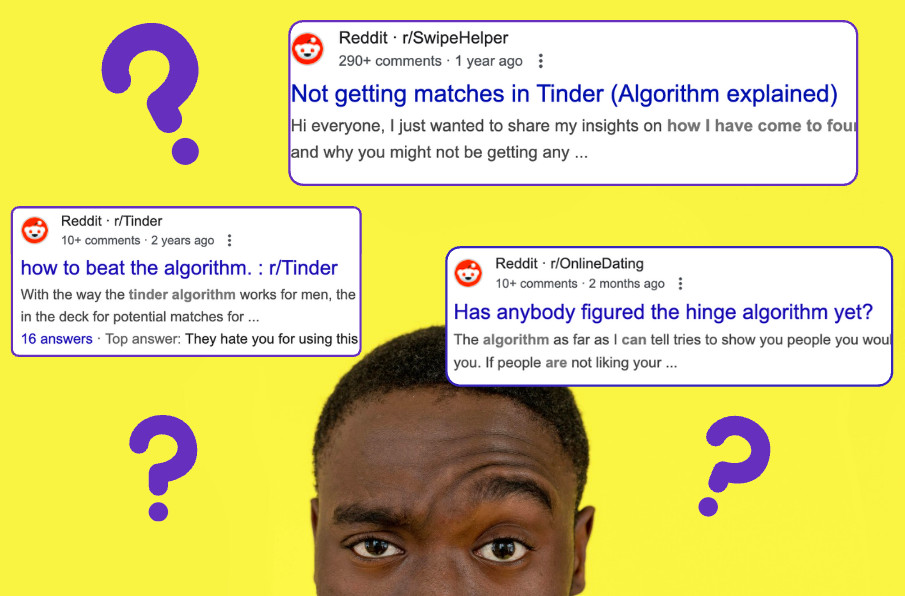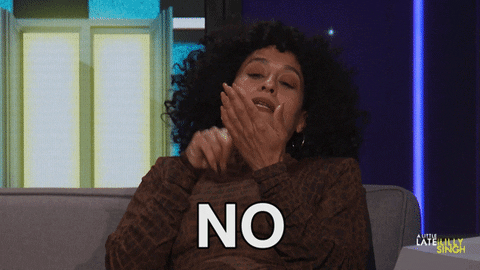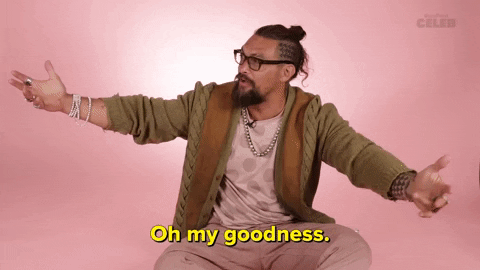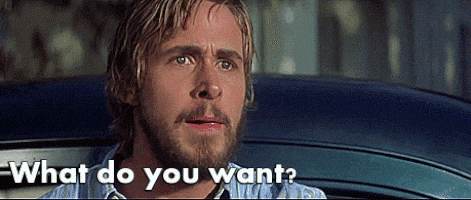Does Tinder have an algorithm to show you hotter matches?
Is Bumble rewarding paid users over free users?
Is there a visibility boost for new members?
We’ll address all your burning questions and more. Let’s get into it.
Do dating apps have algorithms? Yes or no?
Yes. But don’t take what influencers have to say about “cheating the algorithms” as facts. Everyone has a hypothesis, but the only credible source is the app. Ignore stuff like this:
Tinder published everything you need to know about the tech behind their matchmaking algorithm here.
The CEO of Hinge has been pretty open about how their algorithms work, stating, “We don’t really have an attractiveness score.”
Bumble is more hush-hush.
How do dating app algorithms work?
Modern dating apps like Tinder, Hinge, and Bumble use machine learning models to analyze user behavior and optimize match suggestions. Key factors include:
- Activity Level
- Swipe Activity (Incoming and Outgoing)
- Profile Completeness (Photos, Bios, Prompts)
- Photo Analysis
#1. Activity Level
Modern dating app algorithms track a variety of behavioral signals and profile data to determine which profiles to show you (and who sees your profile). The most universal factor is activity level; active users are rewarded with more visibility.
Tinder, for instance, clearly states that it prioritizes profiles that are active and recently online — the goal is to connect people who are using the app at the same time for quicker matches. In short, the more often you log in and swipe, the more prominently your profile will be shown. To stay visible, open your dating apps daily (Tinder, Hinge, Bumble, etc.) and swipe on at least one person each time.
This is pulled from Tinder’s Help Center and is public information.
#2. Swipes
Apps also look at who you swipe right on and who swipes right on you. Every like (“Swipe Right”) or pass (“Swipe Left”) you make is feedback to the system. If you consistently like certain types of profiles, the algorithm will learn your preferences.
Profiles that get liked more often by users tend to be shown more widely, whereas profiles that many people skip may be shown less. This creates a ranking where popular profiles gain momentum.
#3. Profile Completeness
Profile completeness and user-provided info guide the matching algorithm.
Any extra details you add help the system make better matches. If you mention you love hiking or have a dog, Tinder will try to show you people with similar interests (especially now that Tinder allows adding interest tags).
Similarly, Hinge and Bumble encourage filling out prompts or profile questions; doing so not only gives potential matches more to connect with, but it provides more keywords and data for algorithms (or filters) to work with. In essence, a complete and detailed profile, with multiple photos, a bio, and interests, is likely to perform better than an empty one. Think of it like love life SEO.
#4. Photo Analysis
Another under-the-hood factor is AI-driven photo analysis. Dating apps have become surprisingly sophisticated at analyzing the content and quality of your photos.
Tinder has revealed that it uses anonymized cues from profile photos to recommend matches. If you tend to like people who share a certain photo style or setting, the app will show you more profiles with similar photos. It will also show your profile to people who have liked photos similar to yours.
For example, if many of your right-swipes are people with outdoorsy hiking pictures, Tinder takes the hint and adjusts your match suggestions accordingly. This indicates the algorithm is doing image recognition (identifying patterns like “beach photos” or “group selfies”) to personalize results.
To make sure your photos are sending matches (and dating app algorithms) the right impression and test them on Photofeeler first.
How important are my photos and bio for dating app algorithms?
Extremely important.
Today’s dating apps don’t just rely on humans to judge photos, they also use AI photo analysis. Algorithms detect:
- Image clarity
- Face visibility
- Brightness
- Whether you’re alone or in a group
- Emotional expressions (smiles vs neutral faces).
Clear, bright, solo photos get shown more often. Plus, having a completed bio, prompts, and hobbies listed signals you’re a real, engaged user, boosting your ranking even further. Photofeeler can tell you which photos are worth having on your profile for free!
Does swiping right too much hurt my profile visibility?
Yes. When you swipe right on everyone, the app interprets it as spammy or low-quality behavior. Instead of thinking you’re highly desirable, it thinks you’re desperate, and lowers your profile’s ranking.
Best practice: Be selective.
Even if you’re Jason Momoa-level hot but you’re swiping right like the world was ending in 2 minutes, you’re hurting your chances in the long run. (But DM us though 😉, jk)
Do I need to message all my matches?
Yes and no.
If you matched with them, you’re telling the algorithm this person is a “yes” for you. So when you don’t message, you’re basically having this conversation with the app:
Tinder factors in whether you exchange messages and how long your conversations last. A user who just collects matches but never talks might be deprioritized compared to one who actively messages and goes on dates, since the latter is contributing to the app’s performance metrics (meaningful pairings).
Does paying for Premium improve my chances?
Premium (like Tinder Platinum or Bumble Premium) puts you at the front of the line, with priority exposure (the most favorable feature) and no like limits. If your photos and profile are dialed in, it can absolutely increase your chances, especially with people you’re interested in.
But use it after testing your photos on Photofeeler. Don’t pay to promote a profile that isn’t reaching its full potential.
What dating app premium features are worth paying for?
Tinder Boosts are the most effective feature if you want fast exposure. They push your profile to the top for about 30 minutes, and you’ll likely get a surge in likes. Tinder claims up to 10× more views. But keep in mind: it’s just visibility. If your profile isn’t strong, the effect wears off quickly.
Boosts may also show you outside your preferences, meaning more views but lower-quality matches.
Super Boosts are a new thing Tinder is experimenting with, amplifying matches to the 100th degree.
Tinder’s Super Likes (or Bumble’s SuperSwipes and Hinge’s Roses) highlight you to one person — useful for standing out, but only if your profile is compelling.
These features help strong profiles get seen more. They don’t fix weak ones.
Is there a new user boost on Tinder, Hinge, or Bumble?
Yes! Most dating apps do give you a honeymoon phase of heightened visibility. It’s a way to kick-start the matching process and encourage you to stick around.
Enjoy the extra attention when you’re new, but recognize that after a while, the playing field levels out. Your success after the initial boost will then depend on maintaining a good profile and active, positive engagement (there’s no infinite free ride for newcomers).
This temporary boost usually lasts 3–5 days, during which your profile is seen more often and by more active or desirable users. This isn’t a glitch.
How dating apps show new users
| Tinder | Hinge | Bumble | |
|---|---|---|---|
| Confirmed new user bonus? | Yes | Yes | No |
| Visible Badge? | No | Yes, “New Here” | No |
| How long is the effect? | 48–72 hours | 7 days | N/A |
Can you restart the new user boost by deleting and making new profiles?
You can, but it comes with risks.
Dating apps are increasingly aware of this tactic. Apps may flag repeat resets and reduce your visibility instead of boosting it. So, trying to cheat the algorithm usually backfires.
Final Thoughts: Can you beat the dating app algorithm?
As the old saying goes, “If you can’t beat them, join them.”
Play into what apps are telling you works in their algorithms:
- Upload 4–6 high-quality, solo photos (good lighting, genuine smiles).
- Complete all profile sections (bio, prompts, interests).
- Be selective with your swipes — quality > quantity.
- Respond quickly to matches and start conversations.
- Refresh your photos every few months.
- Stay active — daily activity boosts your visibility.
- If you do upgrade to premium, optimize your photos first with Photofeeler to maximize the visibility window.
Dating app algorithms aren’t out to get you, but they are optimized to keep you engaged, not necessarily to make you fall in love tomorrow. By understanding how these systems work, you can position yourself to get better matches faster and enjoy the process a lot more.







